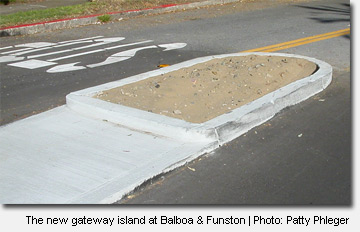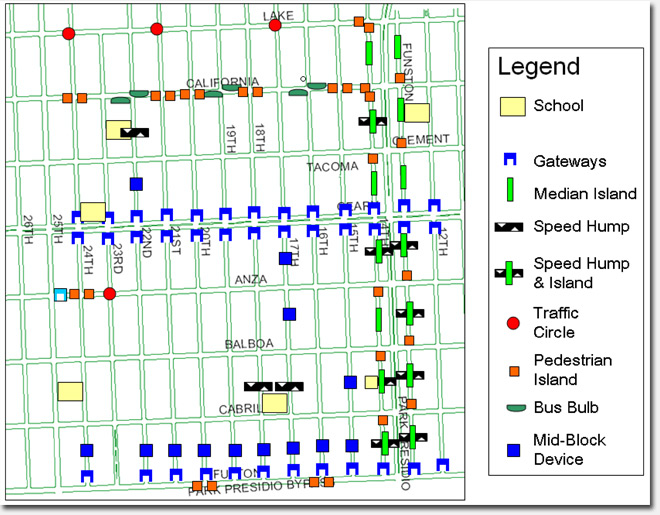 There was a bit of chatter in an online neighborhood group this week about a new gateway island that was installed at Balboa and Funston. The installation is the first part of a larger effort known as the Central Richmond Traffic Calming Project, sponsored by the San Francisco Municipal Transportation Authority (SFMTA)
There was a bit of chatter in an online neighborhood group this week about a new gateway island that was installed at Balboa and Funston. The installation is the first part of a larger effort known as the Central Richmond Traffic Calming Project, sponsored by the San Francisco Municipal Transportation Authority (SFMTA)
The project, a result of San Francisco’s larger Livable Streets initiative, is designed to make neighborhood streets friendlier for pedestrians, children, bicyclists, and motorists. By using a variety of methods, the SFMTA hopes to increase pedestrian safety, reduce speeding and reckless driving, better control traffic spillover from major thoroughfares onto residential streets, and combat excessive noise and traffic levels.
The Central Richmond project will utilize a variety of methods to help calm traffic in the area bordered by Lake and Fulton Streets, and 12th to 26th Avenues (see map below). Over the course of the next three years, crews will install gateway, pedestrian and median islands, speed humps, traffic circles, and bus bulbs in areas where residents have reported issues. The SFMTA originally convened the project after receiving multiple traffic calming requests from Ricmond District residents.
Even planting new trees on a block can help with traffic calming. Studies show that the visual cue of foliage can alert a driver that they are entering a residential area, causing a reduction in speed. However, you have to make sure the trees that are planted survive past the first few months. This was not the case for dozens of trees planted along Anza, Balboa and Cabrillo earlier this year, which died quickly after lack of water. Though not part of the Central Richmond calming project, the DPW is working with the original contractor to replace the trees.
The new gateway island at Balboa and Funston is the first item in the Central Richmond plan to be completed. These gateways are planned for intersections where drivers turn off of busy streets like Geary and Fulton, onto the quieter, residential streets. By putting a hard divider between the lanes of the side streets, cars are forced to slow down on their turns. Pedestrians also have a safe haven as they cross the intersection.
This first gateway island is a test to assess whether they will result in effective traffic calming, according to Dan Provence, the SFMTA Project Manager for the Central Richmond project. So far he says they’ve heard both bad and good things from residents, but overall, their “observations show that it’s effective in slowing traffic down”.
Rather than being concerned about the island’s calming potential, the complaints from one online neighborhood group this week focused on the lack of landscaping in the gateway island. One resident, Patty Phleger, observed that the island is frequently run over by larger trucks (note the black marks on the side of the island), and due to this, “planting in it would be futile”.
When she asked the SFMTA who would be planting and maintaining it, they told her they hoped a resident would do it. Another commenter was a little more succint in his assessment of the sand-filled island: “It’s a dog poop and trash magnet!”
Provence says that the island was supposed to be landscaped by the Department of Public Works (DPW), but their staff cuts and budget shortfall have made that impossible. Provence says “the DPW can’t agree to maintain it as well as it deserves to be maintained”. He admitted they’ll need community support to help bridge the gap. With plans to put in drought resistant plants, Provence says they then “hope to find someone in the area to help with some of the maintenance”.
Already there are neighborhood groups like Park Presidio Neighbors who shoulder some of the maintenance for public areas. The organization was started in 1998 to handle periodic, regular maintenance of the public park areas along the boulevard. Phleger, a PPN member, is not thrilled at the prospect of residents taking on more maintenance responsibility. “We neighbors have enough to do taking care of Park Presidio,” she says. So far, no one has stepped up to plant and take care of the Balboa & Funston island.

A map showing the planned installations from the Central Richmond Traffic Calming Project
Fulton Street, a longtime hazard to pedestrians, is one of the areas that will benefit from the traffic calming project. Drivers love Fulton for its lack of stop signs; many use it as an expressway to Civic Center and downtown. But residents crossing Fulton to catch a bus or enter the park find it risky.
To help counter this, pedestrian islands will be installed in the middle of the street at the intersections of Fulton and 16th and 20th Avenues. This will give pedestrians a safe place to wait if they don’t make it all the way across the street, and the new structures will signal to drivers that they’re approaching a pedestrian area.
The project also calls for a traffic calming method we Americans are not very familar with (and may have issues negotiating initially): traffic circles. Four are planned in total with three along Lake Street.
Which parts of the project get completed and when is largely dependent on funding. Provence says the bus bulb outs are the most costly, followed by traffic circles. Much of the funding comes from the 1/2 cent sales tax revenue passed by Proposition K. Other funds can come from grants like Safe Routes to Schools. Provence says the SFMTA secured $825,000 from the fund and will use some for the traffic calming installations around Alamo School near Calfornia and 23rd Avenue.
Provence says additional installations will occur in 2010 and should include a few more gateway islands on Funston and 14th Avenues, a traffic circle at Anza and 23rd Avenue, and speed humps on 17th and 18th Avenues.
Even with funding secured, more time can pass before construction begins so the community can weigh in on the projects. Neighbors have to be informed well in advance of any upcoming work and in the case of a high impact installation like a speed hump, the SFMTA has to send out ballots to the neighbors on the block to vote yay or nay.
To move forward, at least 50% of those voting have to approve the installation, with at least 25% of the ballots being returned. After neighbor review, it goes to a final public hearing for approval, and ultimately to a SFMTA board for final review. Depending on funding and the approval process, it could take several years to complete all the installations outlined in the Central Richmond Traffic Calming plan.
To find out more, visit the Central Richmond Traffic Calming Project website. Or read the plan outline (PDF).
Sarah B.
In recent years SF installed traffic circles in The Haight, and they were so poorly received and dangerous that SF subsequently removed them. If they didn’t work there, why will they work in The Richmond. Are we just going to have to pay to take them out in 2 years after somebody gets hurt?
What is a traffic circle?
Hi Beth – A traffic circle is a round concrete structure placed in the middle of an intersection. It’s placed in an intersection as a way of slowing down traffic without having to put in stop signs. As cars approach the navigate around it in a counter-clockwise direction and can drive off in any direction.
Sarah B.
Photo of a traffic circle:
http://farm4.static.flickr.com/3468/3948021510_6392bf59fb.jpg
The problem with traffic circles here is mostly one of experience – in Seattle most neighborhoods had them, and part of learning to drive was how to navigate them. However, in Seattle , you don’t have to go around them solely counterclockwise – you can also go clockwise if you’re making a left turn.
This worked only because everyone had them around for so long, people knew what to do. People here aren’t as used to them and I think they get a bit baffled.
They just put up some littler versions of these on 8th and Judah and while everyone was skeptical, I’ve noticed that the drivers are slowing down a little, and it’s easier to cross the street, esp. since we’re near a very busy intersection (9th/Judah) where a lot of buses are coming through both ways.
When it comes to traffic circles, the U.S. is really far behind. I’m glad to see these being brought to the Richmond district. When driving in Europe it takes some getting used to but is more efficient. If you are on the cell phone, texting or just ignoring the traffic laws like so many in the Richmond, yep perhaps they may be more dangerous.
I’m excited, if a little confused. No sign of any traffic calming efforts on my block yet. This will be good… how many times a week do people almost hit me while I’m (carefully) crossing the street? A lot.
Traffic circles are confusing to most motorists in San Francisco, since they need to give right of way to cars approaching from the left. At Stop signs, motorists give right of way to cars to the right. SF would be better adding more stop signs for traffic calming. Less cost, and safer than traffic circles.
You can’t just add stop signs everywhere. The advantage of traffic circles is that they let you flow smoothly, especially if there’s no traffic, but not too fast. With stop signs on every block, it’s stop-go-stop-go which gets ridiculous.
Traffic circles help out in the Parkmerced areas, but I see a lot of people do illegal u-turns the dirty way, versus the correct way of going 360 around the circle.
I was the neighborhood planning director for a spell back east and ultimately persuaded the City to implement several woonerven in our hood. It’s a Dutch strategy whereby roads are transformed into linear parks by randomly dropping trees and park furniture in them. This pedestrian centric approach not only calmed traffic but brought people our of their houses and increased community interaction and made the whole ensemble safer and more humane.
Is a bus bulb a place for Muni to pull in(and therefore OUT of traffic)… if so, will SFMTA actually train & enforce that drivers do so? I see most Muni drivers NOT pulling over the curb so that they don’t “loose” their place on the street… a challenge for passengers & traffic.